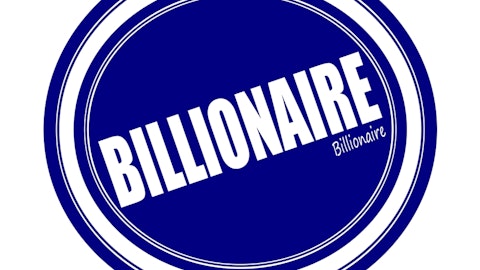Hedge funds and large money managers usually invest with a focus on the long-term horizon and, therefore, short-lived dips on the charts, usually don’t make them change their opinion towards a company. The second half of 2015 and the first few months of this year was a stressful period for hedge funds. However, things have been taking a turn for the better in the second half of this year. Small-cap stocks which hedge funds are usually overweight outperformed the market by double digits and it may be a good time to pay attention to hedge funds’ picks before it is too late. In this article we are going to analyze the hedge fund sentiment towards Philip Morris International Inc. (NYSE:PM) to find out whether it was one of their high conviction long-term ideas.
Overall, in Philip Morris International Inc. (NYSE:PM)’s case, it looks like hedge funds are in a slightly pessimistic mood. The number of long hedge fund positions fell by two during the third quarter and the company was included in the equity portfolios of 45 funds in our database at the end of September. Nevertheless, the level and the change in hedge fund popularity aren’t the only variables you need to analyze to decipher hedge funds’ perspectives. A stock may witness a boost in popularity but it may still be less popular than similarly priced stocks. That’s why at the end of this article we will examine companies such as Medtronic, Inc. (NYSE:MDT), Intel Corporation (NASDAQ:INTC), and Toyota Motor Corporation (ADR) (NYSE:TM) to gather more data points.
Follow Philip Morris International Inc. (NYSE:PM)
Follow Philip Morris International Inc. (NYSE:PM)
Receive real-time insider trading and news alerts
At Insider Monkey, we’ve developed an investment strategy that has delivered market-beating returns over the past 12 months. Our strategy identifies the 100 best-performing funds of the previous quarter from among the collection of 700+ successful funds that we track in our database, which we accomplish using our returns methodology. We then study the portfolios of those 100 funds using the latest 13F data to uncover the 30 most popular mid-cap stocks (market caps of between $1 billion and $10 billion) among them to hold until the next filing period. This strategy delivered 18% gains over the past 12 months, more than doubling the 8% returns enjoyed by the S&P 500 ETFs.

Songquan Deng / Shutterstock.com
With all of this in mind, we’re going to take a look at the fresh action regarding Philip Morris International Inc. (NYSE:PM).
How are hedge funds trading Philip Morris International Inc. (NYSE:PM)?
At the end of the third quarter, a total of 45 of the hedge funds tracked by Insider Monkey were long Philip Morris International, down by 4% from the previous quarter. With hedgies’ positions undergoing their usual ebb and flow, there exists a select group of key hedge fund managers who were boosting their stakes meaningfully (or already accumulated large positions).

Of the funds tracked by Insider Monkey, Cedar Rock Capital, managed by Andy Brown, holds the number one position in Philip Morris International Inc. (NYSE:PM). Cedar Rock Capital has a $1.16 billion position in the stock, comprising 28.3% of its 13F portfolio. The second most bullish fund manager is Tom Russo’s Gardner Russo & Gardner, which holds a $1.0 billion position; the fund has 8.3% of its 13F portfolio invested in the stock. Some other members of the smart money with similar optimism encompass Lee Ainslie’s Maverick Capital, Peter Rathjens, Bruce Clarke and John Campbell’s Arrowstreet Capital, and John Overdeck and David Siegel’s Two Sigma Advisors.
Because Philip Morris International Inc. (NYSE:PM) has experienced declining sentiment from hedge fund managers, logic holds that there were a few funds who sold off their entire stakes in the third quarter. At the top of the heap, Dmitry Balyasny’s Balyasny Asset Management dropped the biggest stake of all the hedgies followed by Insider Monkey, comprising about $48.8 million in stock. Anand Parekh’s fund, Alyeska Investment Group, also dumped its stock, about $47.2 million worth. These transactions are intriguing to say the least, as aggregate hedge fund interest fell by 2 funds in the third quarter.
Let’s now take a look at hedge fund activity in other stocks similar to Philip Morris International Inc. (NYSE:PM). These stocks are Medtronic, Inc. (NYSE:MDT), Intel Corporation (NASDAQ:INTC), Toyota Motor Corporation (ADR) (NYSE:TM), and PepsiCo, Inc. (NYSE:PEP). This group of stocks’ market values are similar to PM’s market value.
| Ticker | No of HFs with positions | Total Value of HF Positions (x1000) | Change in HF Position |
|---|---|---|---|
| MDT | 43 | 1294020 | -7 |
| INTC | 68 | 4883403 | 11 |
| TM | 12 | 300189 | -1 |
| PEP | 57 | 4790976 | -1 |
As you can see these stocks had an average of 45 funds with bullish positions and the average amount invested in these stocks was $2.82 billion. That figure was $4.52 billion in PM’s case. Intel Corporation (NASDAQ:INTC) is the most popular stock in this table with 68 funds reporting long positions. On the other hand Toyota Motor Corporation (ADR) (NYSE:TM) is the least popular one with only 12 bullish hedge fund holdings. Philip Morris International Inc. (NYSE:PM) is not the least popular stock in this group, but hedge fund interest is still below average. This is a slightly negative signal and we’d rather spend our time researching stocks that hedge funds are piling on. In this regard Intel Corporation (NASDAQ:INTC) might be a better candidate to consider a long position.





